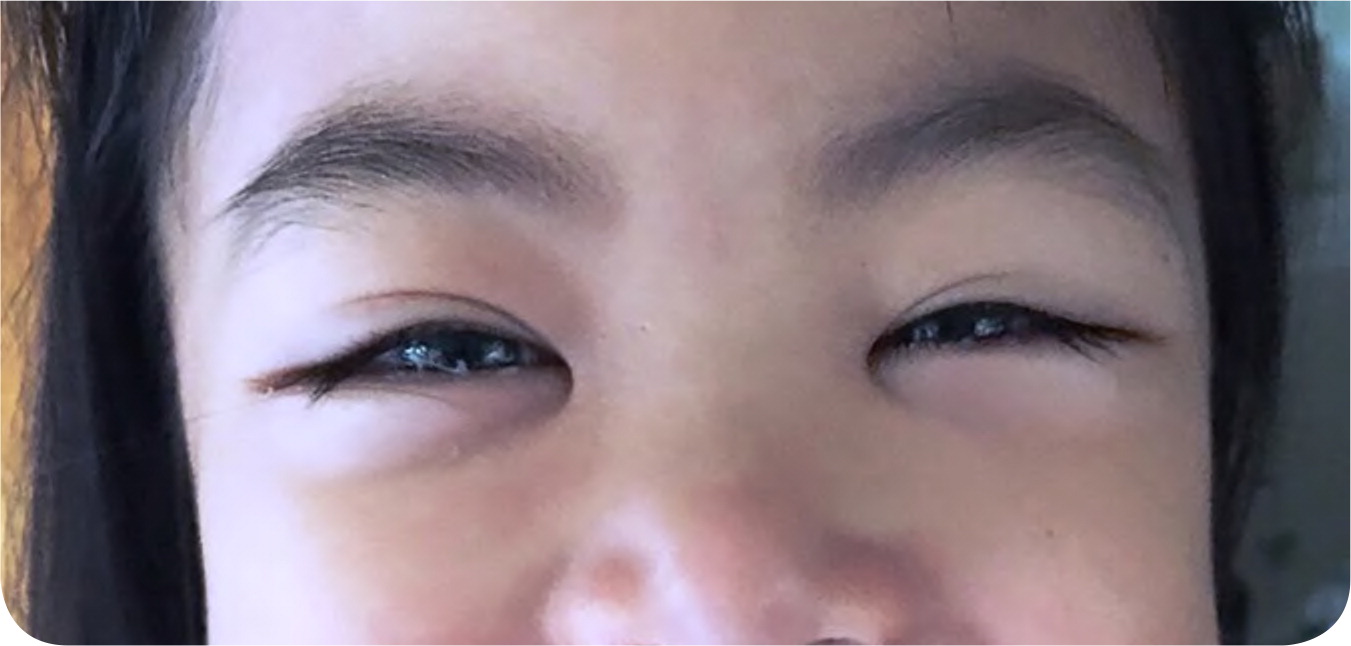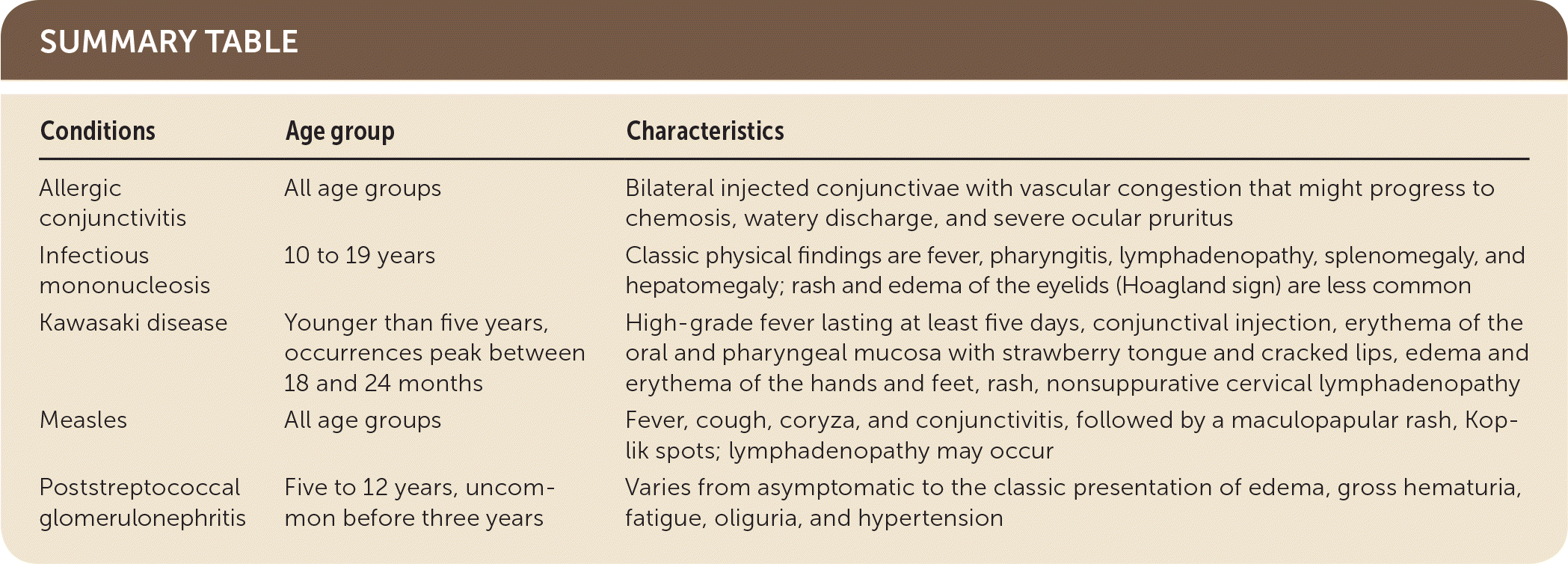
Am Fam Physician. 2019;100(5):313-314
Author disclosure: No relevant financial affiliations.
A six-year-old girl presented with swelling of her eyes that had worsened rapidly over the previous few days. She began feeling sick one to two weeks prior with cold-like symptoms, including nasal congestion, runny nose, and cough. For the past two days, she had sore throat and fever up to 102°F (38.9°C), which mildly improved with acetaminophen and ibuprofen. Her mother noticed a whitish discharge from the posterior tonsillopharyngeal area, and the patient was prescribed amoxicillin. Her fever did not improve after two days of antibiotic treatment. She had no hematuria, dysuria, abdominal pain, nausea, or vomiting.
Physical examination revealed bilateral mild to moderate upper eyelid edema without erythema or discharge (Figure 1). There was erythema of the posterior pharynx and strawberry tongue. A 1.5-cm left anterior cervical lymph node was noted; it was mobile and mildly tender on palpation. The rest of the physical examination was unremarkable. A urine dipstick test in the office showed proteinuria.

Question
Discussion
The answer is B: infectious mononucleosis. This is the clinical syndrome caused by Epstein-Barr virus infection, which affects more than 95% of the world's population, mostly 10- to 19-year-olds.1,2 Patients with infectious mononucleosis have malaise, fatigue, fever, headache, sore throat, nausea, abdominal pain, and myalgia. This prodromal period lasts one to two weeks. The classic physical examination findings are fever (95%), exudative or nonexudative pharyngitis (90%), generalized lymphadenopathy (90%), splenomegaly (50%), and hepatomegaly (10%).1,3 Other less common clinical findings are rash (3% to 15%)1 and edema of the eyelids (Hoagland sign).
Edema of the eyelids has been reported in only a few cases of infectious mononucleosis and is more common in children.4,5 The eyelid edema is bilateral, early, and transient and may occur before exudative pharyngitis or cervical lymphadenopathy develops.6,7 It is not accompanied by pruritus, conjunctivitis, inflammation, or tenderness of the eyelids.8 The etiology of Hoagland sign is unknown, but nasopharyngeal replications of the virus, lymphoproliferation, or lymphatic obstruction is thought to be a contributor.9 This patient's heterophile antibody titer was positive, and streptolysin-O antibody was negative.
The clinical signs associated with allergic conjunctivitis include bilateral injected conjunctivae with vascular congestion that might progress to chemosis, watery discharge, and ocular severe pruritus.1,10 Allergic conjunctivitis is triggered by pollens or perennial allergens and often occurs in conjunction with allergic rhinitis.
Kawasaki disease is characterized by high-grade fever lasting at least five days plus five other clinical criteria, including bilateral nonexudative conjunctival injection, erythema of the oral and pharyngeal mucosa with strawberry tongue and cracked lips, edema and erythema of the hands and feet, rash, and nonsuppurative cervical lymphadenopathy (more than 1.5 cm).1 Peak age of occurrence in the United States is between 18 and 24 months, and 80% of cases occur in children younger than five years.11
Measles is a viral infection characterized by fever, cough, coryza, and conjunctivitis, followed by a maculopapular rash. The rash starts on the face and spreads cephalocaudally and centrifugally.1 Koplik spots usually occur one to four days before the onset of the rash. In severe cases, generalized lymphadenopathy may occur, with prominent cervical and occipital lymph nodes.1
Poststreptococcal glomerulonephritis follows infection of the throat or skin by certain nephritogenic strains of group A beta-hemolytic streptococci.1 It is common in children five to 12 years of age and is uncommon before three years of age. Patients may be asymptomatic or have the classic presentation of edema, gross hematuria, fatigue, oliguria, and hypertension.12

| Conditions | Age group | Characteristics |
|---|---|---|
| Allergic conjunctivitis | All age groups | Bilateral injected conjunctivae with vascular congestion that might progress to chemosis, watery discharge, and severe ocular pruritus |
| Infectious mononucleosis | 10 to 19 years | Classic physical findings are fever, pharyngitis, lymphadenopathy, splenomegaly, and hepatomegaly; rash and edema of the eyelids (Hoagland sign) are less common |
| Kawasaki disease | Younger than five years, occurrences peak between 18 and 24 months | High-grade fever lasting at least five days, conjunctival injection, erythema of the oral and pharyngeal mucosa with strawberry tongue and cracked lips, edema and erythema of the hands and feet, rash, nonsuppurative cervical lymphadenopathy |
| Measles | All age groups | Fever, cough, coryza, and conjunctivitis, followed by a maculopapular rash, Koplik spots; lymphadenopathy may occur |
| Poststreptococcal glomerulonephritis | Five to 12 years, uncommon before three years | Varies from asymptomatic to the classic presentation of edema, gross hematuria, fatigue, oliguria, and hypertension |
